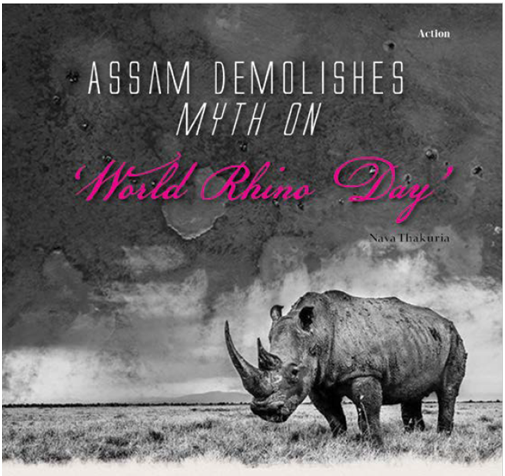
On 22 September, the world witnessed a unique event in Assam of Northeast India, where the authority set 2479 rhino horns on fire as amission to spread the message that the horns do not have anyaphrodisiac value, because of which the gigantic animals, officiallyknown as the greater one-horned rhinoceros (Rhinoceros unicorns), arehunted in Asia and Africa. The pledge of World Rhino Day was todrastically reduce the incidents of rhino-poaching with the governmentinitiatives and full public support.
Assam forest and environment department prepared for the occasionconducting a verification process for rhino-horns, stored in 12government treasuries across the state, to conform if there were anyfake horns made of bamboo-root or plastics. The authority decided todestroy most of the rhino parts, picked up from the cache of 2,623horns, which were recovered from poachers, smugglers or extracted fromthe naturally or accidentally dead ones over the last four decades since 1980.The government, which has otherwise taken zero tolerance policytowards the poaching of wildlife, has preserved 94 horns, based onsize and soundness of architecture for academic purposes those willbe kept put in a proposed natural history Museum at Kaziranga NationalPark and Tiger Reserve, which is widely known for over 2,400single-horn rhinos along with other precious wildlife.Another 50 rhinos linked to various court cases as evidences will alsobe preserved till those are dismissed, stated State Chief MinisterHimanta Biswa Sarma, who led the task at Bokakhat, adjacent to theKaziranga world heritage site and began with Vedic rituals where anumber of priests chanted mantras and took the lead to dispose of the consignment.
With the first of its kind event to destroy rhino horns on such a large scale, the government intends to send a strong message againstthe poaching of wildlife including rhinos. Claiming that the poacherswill have to think now twice, before trying to kill wild animals inAssam, Sarma assured that such activities would not be tolerated. Healso informed that the elevated corridor over the highwaypassing through Kaziranga would be constructed soon for protection ofthe inmates.Often termed as the black ivory, rhino horns are prized as anaphrodisiac, selling for thousands of dollars per kilogram in theinternational illegal market. The animal enjoys great sexual power, asits mating time may continue for around 45 minutes (quite higher thanany other animal). Many people unscientifically believe that one canachieve the unusual sexual power with the help of rhino horns (usingas traditional Viagra).Moreover, the horns are believed to have some medicinal values as thetraditional Chinese medicine requires rhino horns that are believed tocure high fever, stomach ailments and even the cancer. China, Taiwan, Thailand, South Korea, Vietnam and the Middle East are known to behuge markets for the horns, where the use of horns for medicalpurposes and scientific research are legalised. However, theveterinarians claim that there is no scientific analysis that thehorns, which are nothing but the compacted form of hairs, canstimulate human sex.
International Rhino Foundation stated that rhinos have walked the Earth for more than 50 million years and once roamed throughout Africaand Asia. At the beginning of the 20th century, the global rhinopopulation was around 5,00,000 and now after 120 years, 28,000 rhinos(including the two-horn ones) are surviving. Deforestation and landclearance for human settlements have already wiped-out rhinopopulations in Myanmar, Bangladesh, Bhutan, Pakistan, Thailand,Cambodia, Laos, Vietnam, etc.
Nava Thakuria
To read the further articles please get your copy of Eastern Panorama October issue @http://www.magzter.com/IN/Hill-Publications/Eastern-Panorama/News/ or mail to contact @easternpanorama.in We publicly launched our mini-game Chicken Road on April 4, 2024 across all online casinos partnered with Inout Games, with exclusive access at some of the largest operators you know. Its gameplay is simple, yet it has already captivated thousands of players worldwide: you must guide a chicken https://chickensroad.in across a dungeon without getting burned by a flame! Each lane you cross allows you to cash out and exit the game on Chicken Road.


